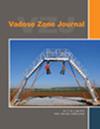在过程模拟的指导下解读大规模长期电地球物理监测结果
IF 2.8
3区 地球科学
Q3 ENVIRONMENTAL SCIENCES
引用次数: 0
摘要
地表电阻率层析成像技术(ERT)被用于一个废物处理场,以监测 17 年间作为污染物通量替代物的地下蓄水层的电特性变化。汉福德废弃物处理场的 BC Cribs and Trenches(BCTT)场地包含 20 条处理沟槽和 6 个处理坑道。废物包括大量锝-99 以及大量硝酸盐和铀-238。2005 年沿 41 个剖面收集了 ERT 数据,以确定与过去液体废物排放有关的体电导率 (BEC) 升高区域的特征。之前对四个钻孔的样本进行的分析表明,硝酸盐浓度与 BEC 之间存在高度相关性。2022 年,在以前未勘测过的区域,沿相同剖面和另外六个剖面重新采集了 ERT 数据。与未受污染的背景区域相比,废物场地受污染区域的 BEC 较高。鉴于之前在该地点发现的硝酸盐浓度与 BEC 之间的相关性,ERT 图像显示了 BCCT 粘土区污染物的空间分布和相对离子浓度。2005 年至 2022 年期间,ERT 差分图像显示,除已知人为地表变化的例外情况外,大多数废物点周围的 BEC 均有所下降。利用合成流和迁移模拟对补给驱动的硝酸盐迁移进行的评估显示,污染物向下迁移的羽流尾端离子强度下降,导致生物相容性降低。因此,我们认为 ERT 差分图像显示了离子向下流动的主要区域。本文章由计算机程序翻译,如有差异,请以英文原文为准。
Interpretation of large-scale, long-term electrical geophysical monitoring guided by a process simulation
Surface electrical resistivity tomography (ERT) was used at a waste site to monitor vadose zone changes in electrical properties as a proxy for contaminant flux over a span of 17 years. The BC Cribs and Trenches (BCCT) site at the Hanford site contains 20 disposal trenches and six disposal cribs. Wastes include a large inventory of technetium-99 and large masses of nitrate and uranium-238. ERT data were collected along 41 profiles in 2005 to characterize regions of elevated bulk electrical conductivity (BEC) associated with past liquid waste discharges. Previous analyses performed on samples from four boreholes showed a high correlation between nitrate concentration and BEC. In 2022, ERT data were re-collected along the same profiles and six additional profiles in an area not previously surveyed. Compared to background uncontaminated areas, BEC was higher in contaminated areas at the waste sites. Given the correlation between nitrate concentration and BEC previously found at this site, ERT images show the spatial distribution and relative ionic concentration of vadose zone contaminants at BCCT. Between 2005 and 2022, ERT difference images showed a decrease in BEC surrounding most waste sites, with exceptions where there were known anthropogenic surface changes. An evaluation of recharge-driven nitrate migration using synthetic flow and transport simulations showed that downward migration causes a decrease in BEC from the decrease in ionic strength at the trailing end of the plume where contaminants migrated downward. From this, we interpret ERT difference images as showing the predominant regions of downward ion flux.
求助全文
通过发布文献求助,成功后即可免费获取论文全文。
去求助
来源期刊

Vadose Zone Journal
环境科学-环境科学
CiteScore
5.60
自引率
7.10%
发文量
61
审稿时长
3.8 months
期刊介绍:
Vadose Zone Journal is a unique publication outlet for interdisciplinary research and assessment of the vadose zone, the portion of the Critical Zone that comprises the Earth’s critical living surface down to groundwater. It is a peer-reviewed, international journal publishing reviews, original research, and special sections across a wide range of disciplines. Vadose Zone Journal reports fundamental and applied research from disciplinary and multidisciplinary investigations, including assessment and policy analyses, of the mostly unsaturated zone between the soil surface and the groundwater table. The goal is to disseminate information to facilitate science-based decision-making and sustainable management of the vadose zone. Examples of topic areas suitable for VZJ are variably saturated fluid flow, heat and solute transport in granular and fractured media, flow processes in the capillary fringe at or near the water table, water table management, regional and global climate change impacts on the vadose zone, carbon sequestration, design and performance of waste disposal facilities, long-term stewardship of contaminated sites in the vadose zone, biogeochemical transformation processes, microbial processes in shallow and deep formations, bioremediation, and the fate and transport of radionuclides, inorganic and organic chemicals, colloids, viruses, and microorganisms. Articles in VZJ also address yet-to-be-resolved issues, such as how to quantify heterogeneity of subsurface processes and properties, and how to couple physical, chemical, and biological processes across a range of spatial scales from the molecular to the global.
 求助内容:
求助内容: 应助结果提醒方式:
应助结果提醒方式:


